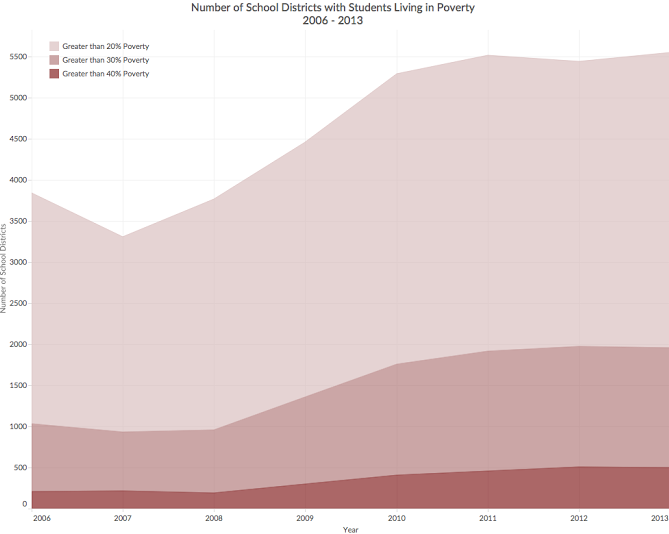Students in America’s schools are much, much poorer than they were nine years ago.
In 2006, 31 percent of America’s students attended schools in “high-poverty” districts, meaning that 20 percent or more of the district's students lived below the federal poverty line. By 2013, however, this number jumped to over 49 percent, according to an analysis of U.S. Census estimates from the nonprofit EdBuild. This means that nearly half of the nation’s children between the ages of 5 and 17 attend schools in communities where a large chunk of families are struggling to get by.
The map below from EdBuild, a new organization that advocates for more equitable state school funding systems, displays this phenomenon. All over the country, in all types of districts and communities, student poverty rates have grown in the past nine years.
Press play on the map -- provided exclusively to The Huffington Post -- to see how poverty has grown since 2006. Use the search function to see how your local school district has fared.
Some states stand out as having seen particularly severe slides toward poverty. Florida has seen an increase of over 2 million students in high-poverty districts. Similarly, California saw an increase of over 1.5 million students in high-poverty schools.
As regions, Southern and Midwestern states saw particularly concerning increases in poverty rates. While the South saw a substantial increase in high-poverty schools, Midwestern states had the largest increase in pupils living in concentrated poverty (defined as 40 percent or more below the poverty line), said Rebecca Sibilia, founder and CEO of EdBuild.
Even though research shows that low-income students typically need more resources than their more affluent peers to succeed, school funding formulas in many states are rigged against helping them. Twenty-three states still fund schools using regressive school funding formulas, meaning that they provide disadvantaged districts with less funding per pupil than more affluent ones, according to EdBuild. Overall, as of 2014, more than half of states were providing schools with less funding than they were prior to the Great Recession.
Impoverished students are at a higher risk for a number of physical and mental health conditions. They are also more likely to attend schools with structural deficiencies and experience traumatic violence in their communities, Sibilia said.
“We are resigning an entire new generation to lower-class life by failing to fund their schools at levels necessary for their needs,” Sibilia said in an email. Sibilia founded EdBuild in 2014 after working as chief operating officer and vice president for fiscal strategy at the education reform group StudentsFirst.

It is clear that more kids are growing up in deprived conditions, regardless of how you define it.
A January analysis from the Southern Education Foundation showed that 51 percent of schoolchildren throughout the country now qualify for free or reduced-price lunch, a program provided to low-income families living up to 185 percent above the poverty line. By comparison, in 2000, 38 percent of schoolchildren qualified for the same program.
“The fact is, we’ve had growing inequality in the country for many years,” Kent McGuire, president of the Southern Education Foundation, said at the time to The Washington Post. “It didn’t happen overnight, but it’s steadily been happening. Government used to be a source of leadership and innovation around issues of economic prosperity and upward mobility. Now we’re a country disinclined to invest in our young people.”
Until serious efforts are made in many states to distribute school funds more equitably, plans to reduce the achievement gap will likely fall flat, said David Sciarra, executive director of the Education Law Center.
“We have these completely dysfunctional … irrational, antiquated, out of date, outmoded school finance systems,” said Sciarra. “The foundational elements you have to have in place [to improve education] -- which is an adequately resourced district and school -- is just not the case in so many states across the nation.”
The Education Law Center releases an annual report card grading states on their levels of school funding fairness. The most recent report card gave 20 states D's or F’s for how fairly they distribute funds between high- and low-income areas.
Still, the political will to change state school funding systems seems to be lacking, said Scott Simpson, director of media and campaigns for the Leadership Conference Education Fund.
“What we’re finding is that the folks who happen to be making these decisions, their kids aren’t the ones in low-income schools,” Simpson said. “In many cases the squeakiest wheels are the folks who happen to be on the more generous side of these formulas.”
